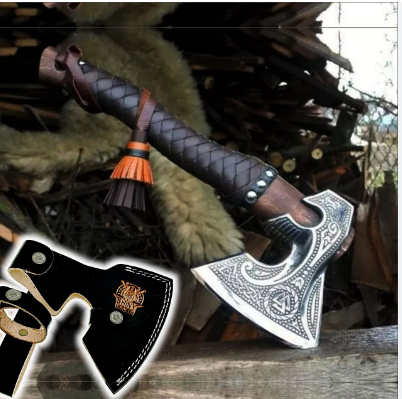The Viking Age, marked by raids, exploration, and epic battles, saw the emergence of two iconic weapons that defined the martial prowess of Norse warriors: the Viking axe and the Viking sword. In this article, we embark on a journey to compare these formidable arms, exploring their design, functionality, and the strategic choices that shaped the tactics of Viking warriors.
- Design and Construction:
The Viking Axe: Viking axes, known for their diverse shapes and sizes, were versatile tools adapted for both practical and martial purposes. The bearded axe, with its elongated lower blade resembling a beard, and the broad axe, featuring a wide cutting edge, were two common designs. The construction often involved an iron or steel head mounted on a sturdy wooden haft.
The Viking Sword: Viking swords, characterized by a straight double-edged blade and a hilt with a distinctive crossguard, were designed primarily for combat. The blades varied in length, with some optimized for slashing and others for thrusting. The hilt typically featured a pommel, providing balance and a secure grip.
- Functionality in Battle:
The Viking Axe: Viking axes were renowned for their versatility in battle. The bearded axe, with its extended lower blade, allowed for effective hooking maneuvers and versatile strikes. The broad axe excelled in cleaving through armor and opponents. The Dane axe, a two-handed variant, provided extended reach and devastating power in combat.
The Viking Sword: Viking swords were prized for their agility and precision. The straight double-edged blade allowed for both slashing and thrusting motions. The hilt design facilitated quick and controlled strikes, making Viking swords well-suited for one-on-one combat scenarios.
- Tactical Considerations:
The Viking Axe: Viking axes were favored for their raw power and adaptability on the battlefield. The bearded axe, in particular, allowed for effective disarming techniques and close-quarters combat. The versatility of the Viking axe made it a reliable choice for raids and skirmishes.
The Viking Sword: Viking swords, with their balanced design, were ideal for duels and individual combat. The ability to execute swift and precise strikes made them effective in one-on-one confrontations. The sword’s versatility, combined with the Viking shield, also provided a balanced offense and defense strategy.
- Practicality in Daily Life:
The Norse Axe: Beyond the battlefield, Viking axes served practical purposes in daily life. Axes were essential tools for woodworking, farming, and building, showcasing the dual functionality that made them indispensable in Norse society.
The Viking Sword: While primarily a weapon of war, the Viking sword held symbolic and ceremonial importance. As a status symbol, it was often adorned with intricate designs and engravings, reflecting the warrior’s social standing.

